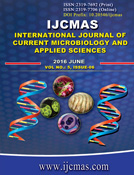


 National Academy of Agricultural Sciences (NAAS)
National Academy of Agricultural Sciences (NAAS)

|
PRINT ISSN : 2319-7692
Online ISSN : 2319-7706 Issues : 12 per year Publisher : Excellent Publishers Email : editorijcmas@gmail.com / submit@ijcmas.com Editor-in-chief: Dr.M.Prakash Index Copernicus ICV 2018: 95.39 NAAS RATING 2020: 5.38 |
The biodiversity, floristic composition and structure of medicinal plants in the fourteen blocks of Nawada District were studied. A total of 105 plant species belonging to 34 families, 75 genera and 5 life forms were recorded. Fabaceae, Moraceae, Meliaceae and Apocyanaceae were the overall diverse families (in terms of species richness) of the adult species, contributing 44.5% of all the species in the study. Trees were the most dominant life form (48.5%) followed by lianas (16.8%), herbs (10.9%), epiphytes (8.9%), shrubs (3.9 %) and the others (4.7%). Species richness among all life forms was highest in the Nda (90.5%) followed by Ap (87.6%), Pb (77%), Sda (73%), Ha (70.25%) and Gp (68.95%). Fabaceae, Moraceae and Meliaceae and Apocyanaceae were the most diverse families distributed in all the fourteen blocks of Nawada. The trees in all the forest types studied were generally tall. The difference in height of tree species could be partly explained by degradation in the form of logging of tall and big trees which has undoubtedly affected the vertical structure. Even though tree size (dbh) correlated with tree height in all the forest types, the relationship was stronger (r = 0.741 to 0.368; p = 0.000- 0.002). Thus, dbh of trees could be a better predictor of tree height. The forest reserve of Nawada looks floristically rich and structurally complex in the face of logging, farming activities and invasion in some parts of the forest. Thus, there is the need to curb the anthropogenic activities and plant invasion so as to protect the integrity of the forest including medicinal plants.
 |
 |
 |
 |
 |